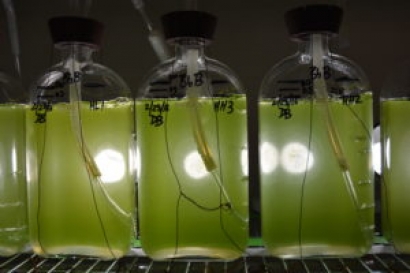
ARPA-E has poured over $22 million into their Macroalgae Research Inspiring Novel Energy Resources (MARINER) program, with the aim of establishing the U.S. as a leader in biofuel production. CSU Energy Institute Researcher Jason Quinn’s project was one of 18 recently selected. Quinn is also an assistant professor in the Department of Mechanical Engineering.
The project is led by Pacific Northwest National Lab Research Engineer Michael Huesemann and is initially being awarded $500,000 over the course of one year, but may be considered for further funding.
ARPA-E was created in 2007 under President George W. Bush to fund research in innovative technologies for tackling energy challenges. One such challenge is making biofuels affordable and competitive. Biofuels originate from living matter, such as plants, as opposed to fuels like coal that are created via geologic processes.
The ambitious CSU project involves a high-tech, three-mile-long recycled carbon fiber cable adrift in the open ocean. The cable will be automatically seeded and set afloat equipped with buoys and GPS sensors. The ultimate goal is to develop a new, economically sound method for producing and harvesting seaweed for biofuels.
“The way forward, if we are going to meet global energy challenges, is to explore new fuel feedstocks,” Quinn said. “I am excited to show that macroalgae can be cultivated in the open ocean and that doing so may one day be a commercially viable option.”
Macroalgae is a classification of seaweed that grows in the ocean and is visible to the naked eye. It can be a range of colors from greens to reds, and is often found in kelp beds.
Quinn will work with Pacific Northwest National Lab, Reliance Laboratories, Composite Recycling Technology Center and Marine Agronomics. The diverse team of public and private entities will begin their work through integrated design and sustainability modeling. Next they will develop their NOMAD (Navy Oceanographic Meteorological Automatic Device) buoy to record and track data. Then, they will develop their macroalgae seed line and harvester equipment.
At all stages, Quinn will conduct techno-economic analysis to gauge the economic feasibility of the project. Quinn will also complete a life-cycle assessment to determine the carbon savings and environmental impact of their method. The team aims to float their macroalgae-harvesting cable off the coast of Washington within three years.
Currently, most domestic biomass produced for liquid fuels occurs on land. While macroalgae production has increased substantially over the past quarter-century, it is not currently capable of achieving the scale, cost and efficiency needed for a viable seaweed-to-fuels process. Increasing productivity will require an innovative, technology-driven approach.
Read more about ARPA-E’s MARINER Program.
Information provided by Colorado State University

